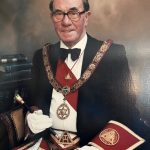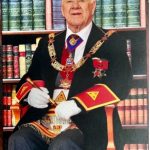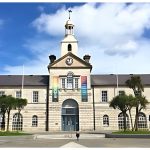Freemasonry is one of the oldest fraternal organizations in the world, originating from medieval stonemasons who built cathedrals and castles. Although not a secret society, it has secret passwords and rituals from the guilds to protect mason knowledge and skills. Modern Freemasonry focuses on preserving ancient traditions, morality, citizenship, and charity. It flourished in the early 1700s in the British Isles, forming Grand Lodges in England, Ireland, and Scotland, spreading globally with the British Empire. Its principles of Integrity, Friendship, Respect, and Charity remain paramount.
Grand Lodge of Ireland
The Grand Lodge of Ireland, the second oldest Grand Lodge of Freemasons worldwide, has existed continuously since 1725. The earliest reference in the Dublin Weekly Journal mentions a meeting to install the new Grand Master, the First Earl of Rosse, on 24 June 1725. It oversees 13 Provincial Grand Lodges in Ireland and another 12 provinces globally.
Friendship Masonic Lodge No.447
Constituted in 1766
The Issue of Lodge Warrant No 447
Prior to the establishment of the Grand Lodge of Ireland around 1725, Freemasonry was conducted independently by each lodge without central governance. Initially, lodges were reluctant to come under the control of the Grand Lodge. To encourage this, Grand Lodge began issuing warrants in 1732, offering certain privileges to the recipients. Some lodges ignored Grand Lodge directives due to their distance from Dublin, rendering Grand Lodge unable to impose its authority effectively.
The Grand Lodge of Ireland issued Warrant No 447 to the Masonic Lodge in Newtownards on November 6, 1766. It is the 24th oldest Lodge in Ireland and the 3rd oldest in the Province of Down. The warrant was signed by the Rt Worshipful and Rt Honourable Earl of Cavan, Grand Master; Rt Wor Holt W. Waring, Deputy Grand Master; George Hart and Peter La Touche, Grand Wardens; and John Calder, Grand Secretary.
Types of Warrants
There was little consistency in how lodges conferred degrees and operated.
Warrants issued by Grand Lodge fell into two categories:
Class 1: Issued between February 1732 and June 1817.
Class 2: Issued from June 1817 to the present time.
Grand Lodge introduced Class 2 Warrants after realizing that Class 1 Warrants granted significant power and authority to the bearers. Class 1 Warrants provided extensive privileges, including:
– Constituting the Grantees as Master and Wardens of a Lodge in perpetuity.
– Granting authority to elect successive Masters and Wardens.
– Allowing Lodges to create their own regulations without stipulation that the Warrant could be cancelled or withdrawn. Practically every Irish Lodge of the 18th century worked the Royal Arch and the High Knight Templar as well as some side degrees.
An example of the power of a Class 1 warrant can be seen if a Brother held a Warrant; it was believed that he could hold a meeting regardless of the residency stated on the Warrant. Some Warrants reached the colonies in the late 18th / 19th century. Closer to home in Newtownards was the case of Farmers Lodge No.1000, whose Warrant originated in Dundonald in 1812. In 1848, due to labour migration and other conditions, the Lodge moved to Conlig between Newtownards and Bangor. Farmers 1000 mainly consisted of miners and tradesmen, so it made sense to move there when the Lead Mines opened. When the mines became unviable, the workforce moved away, leaving just a small number of masons to continue the Lodge’s work.
Having no contact with Grand Lodge and Provincial Grand Lodge regarding financial returns, Grand Lodge demanded the return of their Warrant. This action strengthened the resolve of the remaining members, initiating a couple of new members. Provincial Grand Lodge was asked for approval to move to Newtownards. A representation from Farmers 1000 attended the next Provincial Grand Lodge meeting. With support from Lodge 447, they presented a strong case for transferring the Warrant to Newtownards from Conlig. Farmers 1000 continues to meet in Newtownards and fulfils its commitments to Provincial and Grand Lodge.
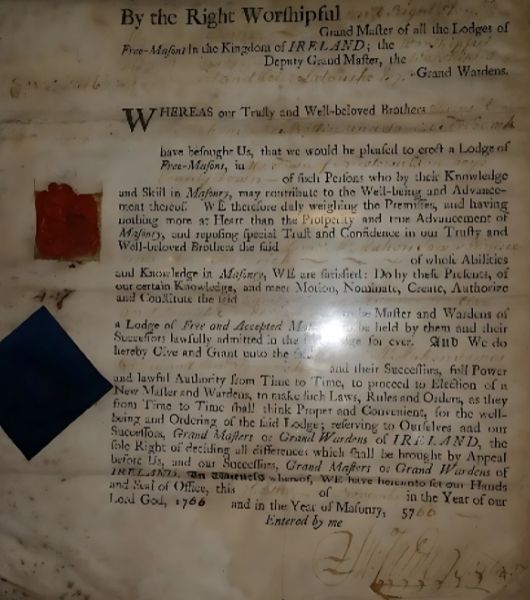
Grantees of Lodge 447
The Grantees were Samuel McMahon, James Wallace, and Samuel Frederick. There is no record of the Dedication of the Warrant or “Installing the warrant.” It was likely one of the Class 1 conditions that allowed them to open and work the Lodge without the usual ceremony, as there were no other Warranted Lodges in the area. The grantees and other brethren likely came from unwarranted lodges, as there is no record of them in the Grand Lodge archives in Dublin. On 6th December, 1766, one month after the Warrant was granted, 26 members were recorded as members of Lodge No 447. They also came from unwarranted lodges in the area.
Worshipful Masters
When the Lodge was first established, the original intention was for a Master to hold office for six months, followed by the election of a new Master.
Samuel McMahon was the first Worshipful Master and completed a second term. Records show that some Masters served for up to two six month terms. This practice persisted until 1883, with Brothers completing one or two six-month terms. After that, the practice shifted to Worshipful Masters serving one-year terms. Notably, Rev Dr Wright served two years in office in 1897/98.
Bylaws
The first regulations or bylaws of Lodge 447 appeared in 1769, comprising 28 handwritten bylaws signed by each member and any new members joining the Lodge. This practice continued until 19th February, 1867. These historical documents were donated to the Grand Lodge of Research on 19th November, 1921.
Trouble with Grand Lodge and Naming of the Lodge
The first suspension of the Lodge 447 warrant by Grand Lodge (along with Lodges 35, 117, 170, 198) was recorded in the Minutes of Grand Lodge Board of General Purpose’s meeting on 3rd August, 1838. A letter admitted that some members participated in a procession on St John’s Day, unaware that it violated Grand Lodge Law. The Board ruled that the stated Warrants be sent to the Grand Lodge Secretary’s office.
On 1st August, 1839, Grand Lodge minutes revealed that a communication from Lodge 447 and twelve other Lodges was read along with a statement from three members of Lodge 447 about processions. Grand Lodge concluded that the communication was a “gross violation of Masonic duty, framed in language disrespectful to the Grand Lodge and betraying ignorance of the spirit and object of our sacred and most useful Institution”. The matter was resolved when the persons named, and the Lodges involved were to be expelled and the Warrants cancelled. They were later restored after Grand Lodge exempted three members from Lodge 447. The Warrant was restored in March 1843.
The Lodge had another brush with Grand Lodge over processions in 1858. They had the Warrant recalled again after another St.John’s Day procession. It was restored on the 19th January 1859 and the Lodge was named Friendship Lodge No.447
Deceit in the Lodge
Advertisement in the Belfast Newsletter, March 1814
“We, the MASTERS and BRETHREN of LODGE Nos. 447 and 985, in a Committee assembled, having heard with astonishment that some of the Members belonging unto our Lodges have been in the habit of passing ILLEGAL BANK NOTES upon the different Banks of Ireland and Scotland, we, holding in detestation such proceedings, hereby give public Notice that any Members suspected or hereafter found trespassing and adhering unto such nefarious proceedings shall henceforth be denied the privileges inherent in Masonry in our Lodges. – Done in the Lodge Room of Lodge 447, at Newtownards, this 29th day of March, 1814.
Signed by order of the Masters of Nos. 447 and 985,
JOHN POTTER, Jun.
Secretary of Lodge No. 447.
“Not to be admitted for a report of forging notes until satisfying the Lodge.”
Meeting Places
Records indicate that Friendship Lodge No. 447 convened in a licensed tavern known as the Cock Inn from 1766 to 1812. The Cock Inn was located at the junction of High Street and South Street in Newtownards, facing Conway Square and the Town Hall. Lodge No. 447 continued to meet there until 1812. Expenses for repairs amounting to £30.00 were recorded following a temporary absence. The landlord at the time was unable to finance the repairs. Upon his demise, his widow assumed control. As further repairs were necessary, the members were reluctant to incur additional costs. Matters escalated when the landlady refused to provide boiling water for the “Lodge Punch” during their Harmony night or post-meeting refreshments.
On 7th July 1812, the minutes confirm that the brethren unanimously passed a motion:
“That a Masonic Lodge should be built for the better accommodation of the brethren thereof,” which was promptly agreed upon, concluding the evening in harmony.
Signed by order, William Park (Secretary)
The New Regent Street Hall
The Brethren secured a lease for half a Cunningham or Scottish acre (3,125 sq yards; a statutory acre is 4,840 sq yds and an Irish or plantation acre is 7,840 sq yds) from a Mr. Johnson, the Brewer, who built Regent House next door. They paid an annual rent of £2. 3s 1.1/2d. After Mr. Johnson’s death, the land reverted to the Marquis of Londonderry, who charged £1.19s 0d per annum. In 1887, a new lease was obtained for a nominal rent of 5 shillings, with specific conditions:
- The hall must be used by a Masonic Lodge under the jurisdiction of the Grand Lodge of Ireland.
- There are to be only three trustees, each a subscribing member of a Masonic Lodge under the same body.
- Trustees’ usual residence must not exceed 15 miles from Newtownards.
When the Lodge received the land, they prematurely harvested the corn, laid the foundations, and compensated the brewer £1 5s 9d for damages. The hall’s construction costs, totalling £188. 6s. 10.5d, were covered by subscriptions or work in lieu of payment. Despite some defaults, the Lodge cleared the debt within four years, maintaining a balance of 7s 7.5d.
Detailed building and labour costs were recorded:
- Stone cutter: 2s 10p per day
- Slater: 2s 9p
- Mason: 2s 8.5p
- Carpenter: 2s 4p
- Labourer: 1s 8p
The cash book stated:
“We the undersigned, having minutely examined the following accounts, being a statement of the Income and expenditure relative to the building, by Robert Hughes and John McAllister as Trustees and Managers for the Lodge. We therefore approve of the zealous and judicious manner in which they have conducted the business entrusted to their care.”
Signed,
John Sloan, William Fee, John Moore, Francis Apperson, and Hamilton Gibson.

The Hall was an unpretentious, two-storey house occupying about two-thirds of the current building, with its front wall extending to the site boundaries. The wall, one storey high, featured an ornamental coping of dressed sandstone, enhancing the Hall’s appearance. The front door jambs, sill, and windowsills were made of cut stone, while the walls were roughcast and whitewashed. The front door accessed only the lower storey, rented as a dwelling-house to a suitable tenant. The upper storey, accessible via an external staircase on the western side, housed the Lodge-room. An inscription above the front door read “Masonic Lodge No. 447 – 1812”. The first recorded meeting in the new hall occurred on 7th September 1813, with approximately seventy members in attendance.
In 1836, a portico featuring fluted sandstone pillars and an ornamental arch with several Masonic emblems was added. The arch included the date in Roman Numerals and the Latin motto “Doceto sed Taceto”, meaning “He must teach, but he must be silent,” or “Teaching by Example.” This clarified the purpose and ideals of Freemasonry to the public.
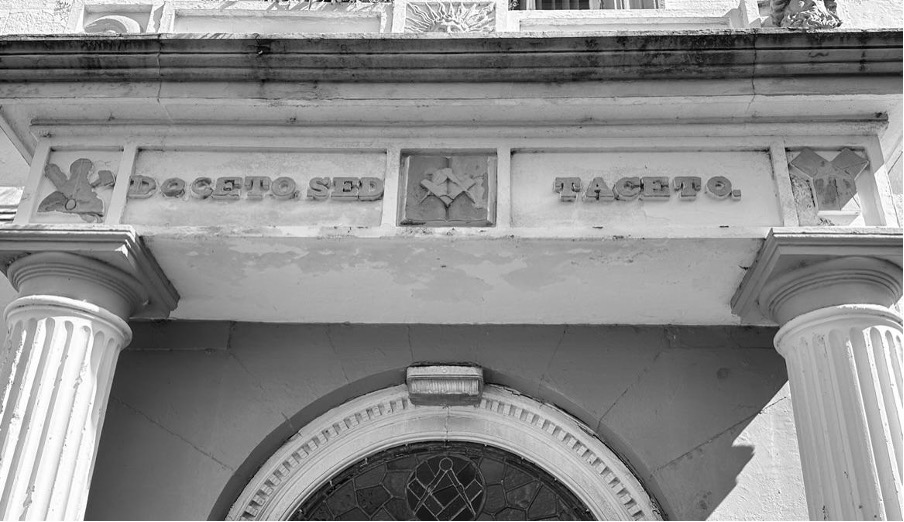
Development of the Hall
1812 – The Brethren of Friendship Lodge No.447 decide to build a purpose-built Lodge Room
1813 – 7th September Lodge minutes recorded the first meeting in the new hall
1862 – The rear garden was enclosed with a wall and a new roof was installed on the Hall.
1864 – Burglars broke into the Lodge Room and stole money from the Lodge Box. Emergency meetings were held, and on January 29th, it was decided to build a stairway from the front door to the Lodge Room landing, which was done. The outside stairs remained in place.
1905 – The Lodge Room was expanded by incorporating the anteroom and building a new one, along with an additional room. Alterations were made to accommodate the Tyler. A new entrance hall with a wider staircase was added, along with a new roof. Two balustrades were erected to support the walls for the new roof. Ventilation was improved with a Boyle’s Ventilating Air Trunk, topped with an ornamental Fleche.
1920 – Discussions took place among Lodges 447, 198, and 1000 in Newtownards about building a large Masonic Hall for all. A committee explored constructing a new hall on Regent Street, but no agreement was reached. Lodge 447’s trustees wanted to keep ownership of their hall and only offer tenantship, which the other lodges did not accept.
1925 – Lodge 447 proposed to Lodges 198 & 1000 the development of a shared Masonic Hall in Newtownards due to high upkeep costs of their own hall. A committee was formed, and an architect estimated the extension cost at £2,500. The trustees of 447 agreed to let other lodges use the new annex equally but insisted on retaining control of the original building. Despite majority support and intervention by the Provincial Grand Master, the trustees’ refusal to relinquish control led to the proposal’s failure.
1967 – Extensive work had to be completed on the Hall. The roof had been leaking and extensive damage had been done to the rafters and there was significant damp in the building. Rafters were replaced and the roof was re-slated. A lot of the water ingress to the roof void had been through the ventilation cupola. Unfortunately, this unique feature of the hall was removed and not replaced. Extensive interior plastering, painting and interior decoration was undertaken.
1973 – A detailed report was presented to the Lodge 447 regarding the progress of the Hall Committee, followed by a discussion. It was proposed and agreed that a Hall Committee be formed with representatives from all the Lodges, Chapters, and Council of Knight Masons utilizing the Hall. The Committee would then appoint Officers not necessarily from Lodge No. 447. The idea of a central single Masonic complex on the Regent Street site was again tabled for discussion. There were several proposals explored which failed to get universal acceptance from all of the Lodges and Hall owners in the town.
1980 – The approval for establishing a Masonic Centre was granted. The refurbishment project was divided into three phases. Stage 1 included significant modifications to the vacated downstairs space at an estimated cost of £10,000, utilizing both a contractor and voluntary labour. The Provincial Grand Lodge pledged financial support for this stage. Revised plans indicated that Phase 1 would cost £85,000 and Phase 2, £228,000. External financial experts were consulted regarding the feasibility of the proposal.
1987 – The Final Account for work completed was presented for payment.
The completion of the renovation and extension of the hall marked the end of a very difficult period for the committee and members of the hall. Thankfully their resilience and perseverance to provide a fitting home for Freemasonry in Newtownards has stood us well for the last thirty years.
2022 – The building’s front facade deteriorated, causing water ingress and damp issues inside. A new Hall Committee was formed to restore the building and create a Community Hub for Freemasons and the public. Plans for a modern, accessible two-storey Masonic Centre and Community Hub have been developed. A fundraising strategy focuses on the hall’s heritage and its historical and community significance in Newtownards.
